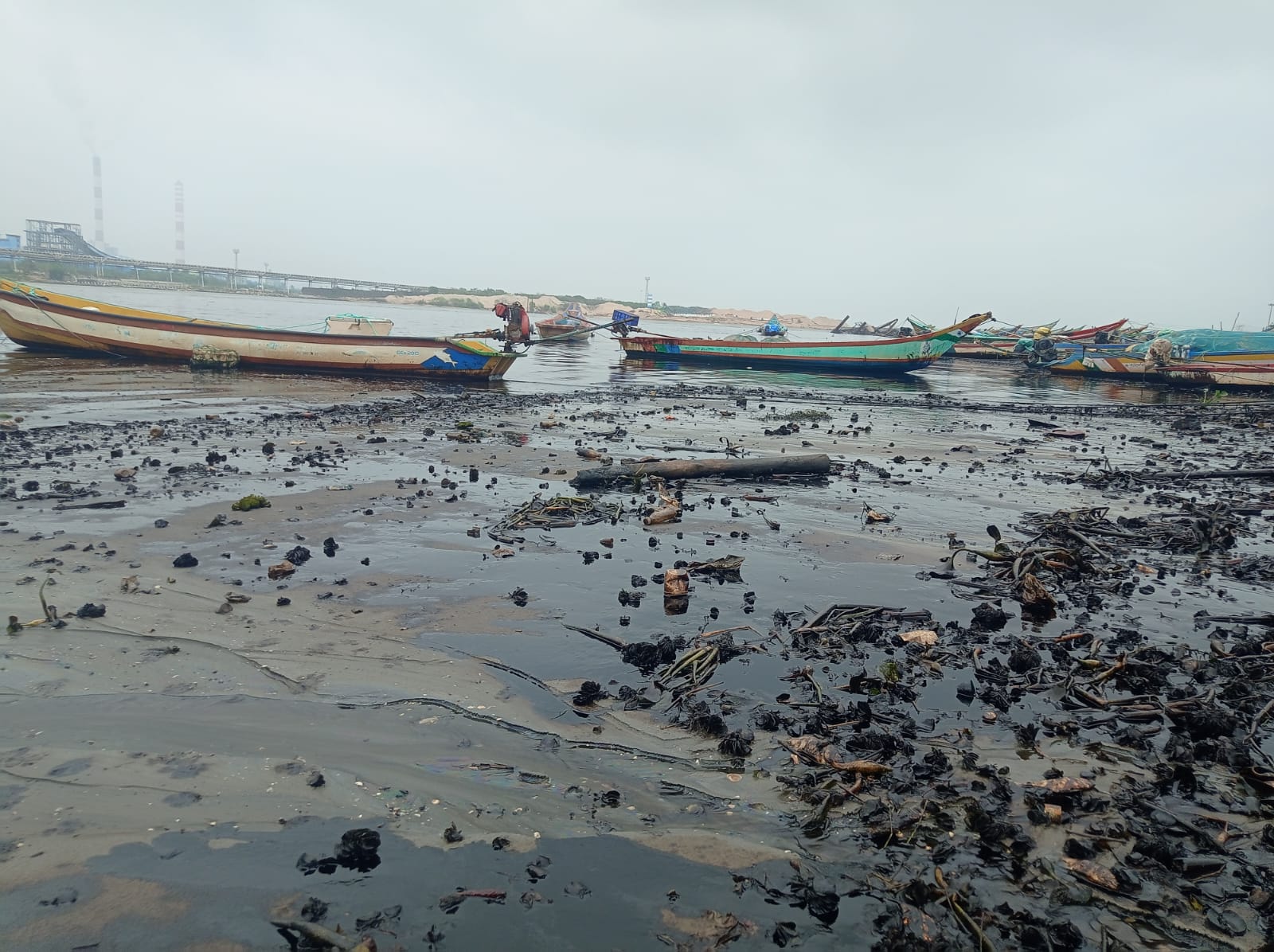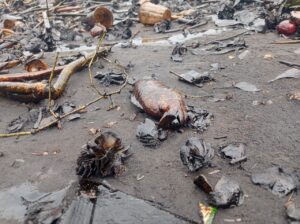On 4 December, an oil spill by the Chennai Petroleum Corporation Limited occurred, contaminating the Kosasthalaiyar river via the Buckingham Canal.

The oil spill extended 20 sq km, according to the Indian Coast Guard. (Supplied)
D Venkatesan, a 36-year-old fisherman from Ennore Kuppam — a fishing village in Chennai — did not let hope fade even when Cyclone Michaung, with its squally winds, stopped him from venturing into the sea for his livelihood in early December.
He had followed the advisory issued by the Regional Meteorological Centre and stayed at home, like other fishermen from KTCC (Kancheepuram, Tiruvallur, Chennai, and Chengalpattu) districts, knowing it would end soon.
But a week after the cyclone, Venkatesh is a broken man.
He cannot venture into the sea anytime soon — not because of the cyclone but now because of the oil spill that happened on 4 December from the Chennai Petroleum Corporation Limited (CPCL), contaminating the Kosasthalaiyar river via the Buckingham Canal.
The oil spill reached the Bay of Bengal via Ennore Creek, leaving the shores and the water unfit for fishing.
“My fishing nets are covered in oil. The shore, the sea, and my boat…there is oil everywhere,” Venkatesan told South First on Monday, 11 December.
As the layer of oil on the water prevents permeation of oxygen, there would be a huge loss of marine life.
Oil spill clean-ups are always a time-taking affair, as was seen during the Ennore oil spill in 2017 when an outbound empty tanker, the BW Maple, collided with an inbound loaded oil tanker, the Dawn Kanchipuram, outside Ennore’s Kamarajar Port.
“Typically after a cyclone, the catch would always be great. We were excited to venture into the sea. But I was devastated to see oil on the shore,” he rued.
The waters of Kosasthalaiyar river and the sandy shores of the Bay of Bengal now resemble a death trap, as layers of crude oil coat the surface, washing hundreds of dead fish on to the shore.
The extent of pollution is so severe that, as per the Indian Coast Guard, the oil spill has spanned about 20 sq km, extending at sea from the Kosasthalaiyar river mouth till Kasimedu Harbour.
Prakash S, another fisherman from Kattukuppam, tries to avoid looking at his boat and the six nets that were painted with dark oil. “I have to spend a lakh to replace them. Covered in oil, these nets cannot be repaired,” he told South First.
The environmental impact of the oil spill is so severe that the fishermen predict depletion of catch for the next six months. While small quantities of oil spillage has always been noticed at these fishing hamlets every monsoon, this is the second severe incident of oil spill after the one in 2017.

Boats have been submerged in oil for about a week now. (Supplied)
“There are deposits of oil on boats and nets. Chemicals present in the oil will melt the boat’s fibre, with a threat of water leakage when in sea. This can result in loss of lives if not repaired,” Kumaresan, a fisherman, lamented to South First.
Each boat is estimated to cost anywhere between ₹1.6-₹2.8 lakh and a fishing net costs ₹20,000-₹40,000.
Around 8,000 fishing families from eight fishing hamlets — Sivan Padai Veedu Kuppam, Kattukuppam, Thalankuppam, Mugadwarakuppam, Ernavur kuppam, Nettukuppam, Chinna Kuppam, and Periya Kuppam — are estimated to be affected by the oil spill.
“We are not fighting for luxury. Ours is a hand-to-mouth existence. We cannot light our pots without income from fishing,” said a visibly frustrated Saritha K, the wife of a fisherman whose nets were covered in oil.
“The state government should take proactive measures and ascertain the compensation to fisher folk at the earliest,” environmentalist Durga Moorthy suggested, while speaking to South First.
Oil spills, if not contained immediately, will have a harsh effect on the biodiversity. As per a report by Suzhal Arivom, an environmental organisation, the leak will destroy the seaweed, which is home to marine life.

The December 2023 oil spill has resulted in the loss of marine life. (Supplied)
Oil destroys the water repellent ability of shore birds’ feathers, thus exposing them to harsh elements. “We witnessed several plants, fishes, and a few birds impacted by this oil spill in our short field visit. Without the ability to repel water and insulate from the cold water, birds and mammals will die from hypothermia,” the report stated.
Many birds and animals also ingest oil when they try to clean themselves, which can poison them.
It must be remembered that the east coast is the nesting ground for migrating sea turtles that are expected to come from January. “Juvenile sea turtles could be trapped in oil and mistake it for food. Large fishes and shellfish (crustaceans and molluscs) may not be exposed immediately, but can come into contact with oil if it is mixed into the water column,” the report added.
Issuing directions to CPCL under Section 33A of the Water (Prevention & Control of Pollution) Act, 1974, the Tamil Nadu Pollution Control Board (TNPCB), on 11 December, said that CPCL shall identify hotspots in Buckingham Canal, Ennore Creek, and adjoining areas where the oil deposits/oil slick are stagnated and take necessary remedial measures on a war-footing basis.
“If CPCL is found to discharge oil containing water/polluted water against the norms set out for industries under provisions of the Water (Prevention and Control of Pollution) Act, 1974, their operations are liable to be suspended,” a release from TNPCB said.
While CPCL denied a leak at their refinery in Manali, North Chennai, they deployed gully suckers to remove oil traces from the canal and organised medical camps to treat citizens complaining of cough.
The release from TNPCB also stated that CPCL should also pay environmental compensation and compensation to the families adversely impacted due to the oil spill, including the loss of livelihood. “CPCL shall carry out a Leak Detection & Repair Study (LDAR) and comprehensive mapping study with a reputed technical institution,” it stated.
District collectors of Chennai and Tiruvallur, the Fisheries Department, and the Environmental Department are involved to ascertain the loss for fishermen and the biodiversity.
Agencies specialising in such oil spillage management were mobilised from Chennai and Ennore ports. “These agencies have planned to deploy oil barriers and specialised machinery like gully suckers to absorb excess oil,” a press release from the state government said.
As many as 20 boats with men and materials were pressed into service on Monday in the Ennore Creek area for mitigation works. A team of senior officers from TNPCB, Forest and Revenue departments are working in close coordination with district collectors and monitoring officers to expedite the mitigation and the relief works, the release added.
The oil leak, which is at its worst at the Kosasthalaiyar river, underlines the failures of the state government. It may be noted that the National Green Tribunal, in July 2022, ordered the Environment Department to come up with a detailed project report to study the Ennore creek and protect wetlands.
“If there was a plan, there would have been measures regarding containing contamination of discharges into the river,” said Durga Moorthy.
Kosasthalaiyar river, with the double carrying capacity of Adyar and Cooum rivers, is a natural water draining system. It is also home to many encroachments, including illegally laid transmission towers and construction debris that have not been properly removed after the erection of towers belonging to The Tamil Nadu Transmission Corporation Limited (TANTRANSCO).

May 01, 2024

May 01, 2024

May 01, 2024

May 01, 2024

May 01, 2024

Apr 30, 2024